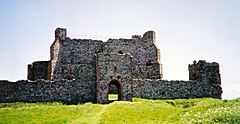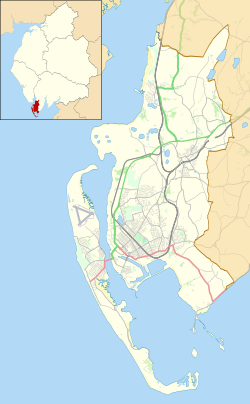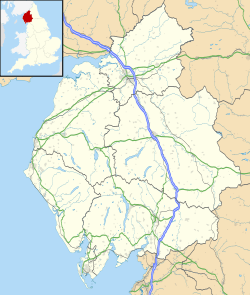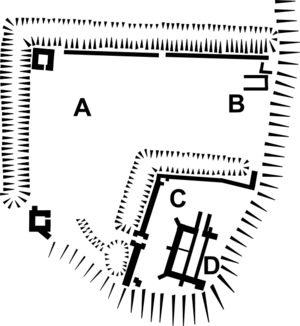Piel Castle facts for kids
Quick facts for kids Piel Castle |
|
|---|---|
| Furness Peninsula, England | |

Piel Castle, showing the inner gatehouse, inner bailey wall and keep
|
|
|
Location in Barrow-in-Furness Borough##Location in Cumbria
|
|
| Coordinates | 54°03′45″N 3°10′24″W / 54.0626°N 3.1733°W |
| Type | Concentric castle |
| Site information | |
| Owner | English Heritage |
| Open to the public |
Yes |
| Condition | Ruined |
| Site history | |
| Materials | Beach stone and red sandstone |
| Events | Landing of Lambert Simnel in 1487 |
Piel Castle, also called Fouldry Castle, is an old castle found on Piel Island. This island is located off the coast of the Furness Peninsula in north-west England. It was built in the early 1300s by John Cockerham, who was the Abbot (leader) of nearby Furness Abbey.
The castle's main jobs were to watch over the busy local harbour and to defend against attacks from Scotland. It was made from stones found right on the beach. Piel Castle has a big central tower called a keep, surrounded by two protective walls known as inner and outer baileys. In 1487, a young man named Lambert Simnel, who pretended to be a prince, used the castle as a base. By 1534, the castle was already falling apart. Today, it is looked after by English Heritage and is a popular place to visit.
Contents
The Story of Piel Castle
Piel Castle stands on Piel Island, looking over the deep harbour of Piel. This area is now known as Barrow-in-Furness. Some people think there might have been an older fort on the island in the 1100s, but we are not sure.
Building the Castle
The castle we see today was built around 1327. This was when King Edward III gave permission to the Abbot of Furness Abbey to build a castle there. The Abbey needed protection because Scottish raiders had attacked them in 1316 and 1322. The castle was designed to control trade coming through the harbour and to keep the area safe.

Experts believe the castle was built in a few stages. First, the central keep was likely built as a summer home for the Abbot. As the threat from Scotland grew, a strong inner wall was added to protect the keep better. Finally, an outer wall was built to complete the castle's defences.
Challenges and Changes
In 1408, the Abbot John Bolton thought the castle was too expensive to keep. He tried to pull down parts of it, but King Henry IV stopped him. The castle was then rebuilt around 1429.
The monks at the Abbey even used the castle for smuggling! They were illegally selling wool, which was supposed to be sold only through the French port of Calais.
A famous event happened in 1487 when Lambert Simnel landed on Piel Island. He was a young man who claimed to be a prince and wanted to become king. He gathered supporters at the castle before heading inland. He was later defeated in a big battle.
By 1534, the castle was already in ruins. When the monasteries were closed down in 1537, Piel Castle became the property of the King. Later, it was given to the Duke of Albermarle.
Saving the Castle
By the late 1700s, the island was used by maritime pilots who guided ships. The castle then came into the hands of the Dukes of Buccleuch. In 1811, the famous poet William Wordsworth visited and wrote a poem about "Peele Castle."
The sea started to cause a lot of damage to the castle. One side of the main tower collapsed in the early 1800s. In the late 1870s, Walter Scott, the Duke of Buccleuch, bought the rest of the island. He spent a lot of money fixing up the castle between 1877 and 1878. He built new walls to stop the sea from causing more damage and repaired the stone parts of the castle.
In 1919, John Scott, another Duke of Buccleuch, decided to sell the island and castle. But the local mayor, Alfred Barrow, stepped in. The Duke then agreed to give the castle and island to the local town in 1920. It was given as a memorial to remember those who died in World War I.
In 1973, the castle became the responsibility of the government. Now, English Heritage looks after it as a place for tourists to visit. The castle is a protected building, meaning it is very important and must be preserved.
Castle Design
Piel Castle is built in a concentric design. This means it has a central tower (the keep) surrounded by two layers of protective walls, like rings. These walls extend out to the north-west. The castle was built using stones from the local beach, held together with mortar. The nicer stone parts, like doorways and windows, were made from red sandstone brought from the mainland.
The Keep
The main tower, or keep, has three floors and stands about 45 feet (13.7 meters) high. It is about 76 feet (23 meters) long and 74 feet (22.5 meters) wide. It has strong supports called buttresses and a tower on its south-eastern corner. The original entrance was on the ground floor. Later, a gatehouse was added on the north side, moving the entrance up to the first floor.
The keep had large windows on the first and second floors, though the lower parts of these were later blocked up. The inside of the keep was divided into three sections, creating a central hallway on each level. The eastern side of the keep has fallen down because of sea erosion. Some experts think the keep was more like a large house tower than a typical castle keep.
Protective Walls and Moats
The inner and outer walls of the castle have also been damaged by the sea. They originally formed square shapes around the keep and were protected by ditches. The outer wall is not very strong today, and it might have been quite weak even when it was first built. It was protected by a moat up to 13 meters (42 feet) wide and 3 meters (10 feet) deep.
Both the inner and outer walls had towers. The outer wall towers were about 15.5 feet (4.7 meters) wide. The inner wall was about 8 feet (2.4 meters) thick and protected by a moat about 25 feet (7.6 meters) wide. The towers on the inner wall were added later. A gatehouse was also built in the inner wall shortly after the castle was finished. These defences were a bit old-fashioned for the time they were built.
Inside the outer wall, there is a stone building called "the chapel." It is about 31 feet (9.4 meters) long and 15 feet (4.5 meters) wide. We don't know what it was originally used for. It seems to have been built late in the castle's history, possibly after it was already falling apart.
Local Legends
There are old stories about a secret tunnel connecting Piel Castle and Furness Abbey. People said the monks used it to escape from the mainland. However, there is no such tunnel.




